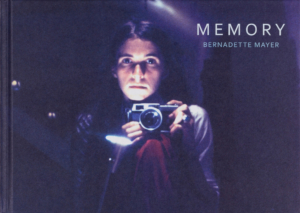Memory
Bernadette Mayer

hardcover, 10 × 7.25 in.
336 pages, all color
978-1-938221-25-5
published in 2020
second printing in stock
Marathon reading of the entirety of Memory in Great Barrington on Sunday, July 14.
In July 1971, Bernadette Mayer embarked on an experiment: For one month she exposed a roll of 35mm film each day and kept a journal. The result was a conceptual work that investigates the nature of memory, its surfaces, textures and material. Memory is both monumental in scope (over 1100 photographs, two hundred pages of text and six hours of audio recording) and a groundbreaking work by a poet who is widely regarded as one of the most innovative writers of her generation. Presaging Mayer’s durational and constraint-based diaristic works of poetry, it also evinces her extraordinary—and unheralded—contribution to conceptual art.
Mayer has called Memory “an emotional science project,” but it is far from confessional. Rather, this boldly experimental record follows the poet’s eye as she traverses early morning into night, as quotidian minutiae metamorphose into the lyrical, as her stream of consciousness becomes incantatory. The space of memory in Mayer’s work is hyper-precise but also evanescent and expansive. In both text and image, Mayer constructs the mercurial, fleeting consciousness of the present moment from which memory is—as she says—“always there, to be entered, like the world of dreams or an ongoing TV show.”
This publication brings together the full sequence of images and text for the first time in book form, making space for a work that has been legendary but mostly invisible. Originally exhibited in 1972 by pioneering gallerist Holly Solomon, it was not shown again in its entirety until 2016. The text was published without the photographs in 1975 and has been long out of print.
Best of 2020 at the New York Times, Brooklyn Rail, Cultured, Elephant and Ursula
Read an excerpt (July 15), an extended biography of Mayer by her daughter Marie Warsh, and a short history of Memory, all from the book.
listen, watch, read
listen to the original 1972 audio recording in the Bernadette Mayer Papers in the Special Collections & Archives at UC-San Diego.
watch Mayer reading for Artforum; and the remarkable daily reading series at Poets House in which contemporary poets read short selections from each day of Memory on the corresponding day in July 2020 online during the shutdown.
read the excellent essays on Mayer’s work at POST45, including an interview with publisher Lisa Pearson about the making of the Siglio edition.
and the outpouring of elegies and appreciations from so many fellow writers and friends.
about the author
Bernadette Mayer passed away on November 22, 2022. We remember her here where you will also find links to many tributes and remembrances that attest to the immense love for her work and its profound influence. On May 12, 2023 the Bernadette Mayer Memorial Celebration took place at the Poetry Project in NYC.
Bernadette Mayer, 1945-2022, authored of over thirty books including the acclaimed Midwinter Day (1982), a book-length poem written during a single day in Lenox, Massachusetts, as well as the The Desires of Mothers to Please Others in Letters (1994), and most recently Milkweed Smithereens which—like Works and Days (2016)—was a finalist for the National Book Critics Circle Award in Poetry. Associated with the New York School as well as the Language poets, Mayer was also an influential teacher and editor. In the art world, she is best known for her collaboration with Vito Acconci as editors of the influential mimeographed magazine 0 TO 9.
press
This dreamy volume gather[s] the eleven hundred photographs and two hundred pages of rolling prose that Mayer produced in those thirty-one days. It is as much a conceptual exercise as a diaristic one, a Hydra dancing at the intersections of language and image, calling forth what time and a voracious mind can create there.
—Jennifer Krasinski, Bookforum
The photos are necessarily small (roughly 2½ inches by 1¾ inches), arrayed in grids of nine, along with intermittent full-page blowups, and as lovely as individual images are, their power is cumulative: a wide-ranging work of personal cinema, in stills. Her journal provides the narration in galloping long-breath prose poetry that feels as spontaneous and alive as the pictures.
—Lucy Sante, New York Times Best Photography Books 2020
What is the “first thought” that precedes all that manufactured language and how do we build a language to accommodate that first thought? Memory is a prodigious effort to do so, to move into a new visual and textual language where Mayer can explore the simmering possibilities of consciousness. This is why the snapshots do not correlate with the text, but instead … “converge and diverge.” That weaving between poetry and image opens spaces of light, time, language, awareness, expression, and creation.”
—Marcella Durand, Hyperallergic
William James once distinguished between ‘“substantive” and “transitive” states of mind: the difference between “a feeling of blue or a feeling of cold” and “a feeling of if, a feeling of but, a feeling of by.’” Memory tempts you to linger on the substantive, but, with its bountiful cars, highways, gas stations, rivers, and bridges, it’s really about getting somewhere. It is happiest in the in-between, and hyperalert to its own transit from one word and image to the next. There are many road trips’ worth of words—often erratically, racing to catch up with memories before their vividness fades … Here, as on a highway, language passes at a steady, constant clip.
—Dan Chiasson, New Yorker
Memory directly links a long legacy of experimental writing. It combines the permutational prose of Gertrude Stein with the casual coterie references of the New York School poets, along with the non-sequitur juxtapositions familiar to both. It also merges an impersonal, conceptual framing project with biographical content, and exhaustive inclusivity with the textual focus of formal devices: lists; appropriated transcriptions of ambient, non-literary language; homophonic transformations, etc. … Siglio’s publication gives it the chance to continue to serve as the hinge to whatever follows those writers and movements in turn.
—Craig Dworkin, Times Literary Supplement
More incredibly thoughtful discussions of Memory: Art Agenda (Wendy Vogel), Burlington Contemporary (Amy Tobin), BOMB (Diana Hamilton), Brooklyn Rail and The Nation (Tausif Noor), Little Brown Mushroom (Rebecca Bengal) JSTOR (Lindsay Garbutt), London Review of Books (Janique Vigier), Music & Literature (Sandra Simonds), New York Review of Books (Gillian White), Rain Taxi (Stephanie Anderson), and a starred review at Publishers Weekly!
more by and about Bernadette Mayer
Writing experiments by Mayer at UPenn, new writing at Frieze, her poetry collections in print at New Directions, single poems and a short bio at the Poetry Foundation, and a 2016 profile in the New Yorker.
see also
✼ the improbable:
from Issue, No. 1 (Time Indefinite), “Dick Higgins, Publisher: Notes Toward a Reassessment of the Something Else Press Within a Small Press History” by Matvei Yankelevich: “To find connections between poetry, small press publishing, and the art scene of the early 1960s, one may look no further than Higgins’ own network.”
[...]
